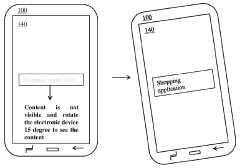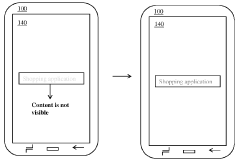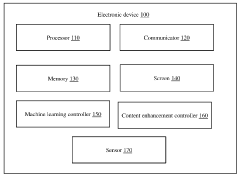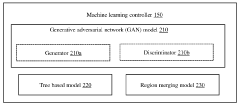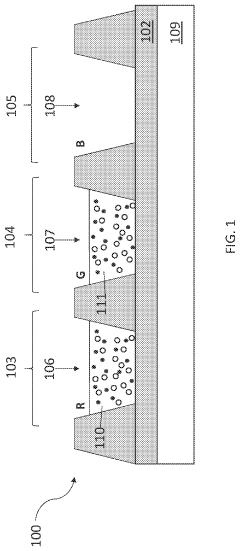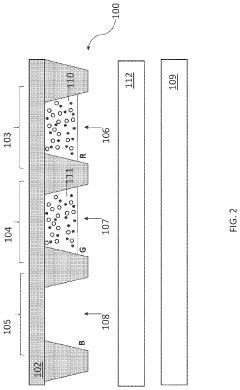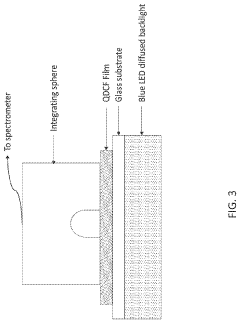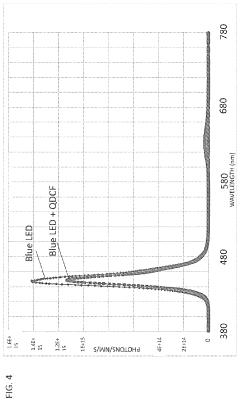How to Optimize User Experience with QLED Displays?
JUN 20, 20258 MIN READ
Generate Your Research Report Instantly with AI Agent
Patsnap Eureka helps you evaluate technical feasibility & market potential.
QLED Display Evolution
QLED display technology has undergone significant evolution since its inception, driven by the continuous pursuit of enhanced visual experiences. The journey began with the introduction of quantum dot technology in the early 2010s, which promised improved color accuracy and brightness compared to traditional LED displays. Initially, quantum dots were used as a color-enhancing layer in LCD panels, marking the first generation of QLED displays.
As research progressed, the second generation of QLED displays emerged, featuring more advanced quantum dot materials and refined manufacturing processes. This iteration brought about wider color gamuts, higher peak brightness, and improved energy efficiency. The integration of local dimming technologies further enhanced contrast ratios, addressing one of the key limitations of early QLED displays.
The third generation of QLED displays saw the introduction of self-emissive quantum dot technology, a significant leap forward in display performance. This innovation eliminated the need for a separate backlight, allowing for true pixel-level control of brightness and color. The result was deeper blacks, more vibrant colors, and improved viewing angles, narrowing the gap between QLED and OLED technologies.
Recent advancements have focused on refining quantum dot materials and their application methods. The development of cadmium-free quantum dots addressed environmental concerns, while new deposition techniques improved uniformity and reduced production costs. These improvements have made QLED displays more accessible to a broader market, from high-end televisions to mobile devices and professional monitors.
The latest evolution in QLED technology involves the integration of artificial intelligence and machine learning algorithms. These smart features enable real-time content analysis and optimization, dynamically adjusting display parameters to enhance image quality and user experience. Additionally, advancements in quantum dot synthesis have led to more stable and efficient materials, extending the lifespan of QLED displays and improving their long-term performance.
Looking ahead, the QLED display evolution is expected to continue with a focus on higher resolutions, faster refresh rates, and even thinner form factors. Research into flexible and transparent QLED displays is also underway, promising to expand the technology's applications beyond traditional screens. As the technology matures, efforts to optimize power consumption and improve sustainability will likely play a crucial role in shaping the future of QLED displays.
As research progressed, the second generation of QLED displays emerged, featuring more advanced quantum dot materials and refined manufacturing processes. This iteration brought about wider color gamuts, higher peak brightness, and improved energy efficiency. The integration of local dimming technologies further enhanced contrast ratios, addressing one of the key limitations of early QLED displays.
The third generation of QLED displays saw the introduction of self-emissive quantum dot technology, a significant leap forward in display performance. This innovation eliminated the need for a separate backlight, allowing for true pixel-level control of brightness and color. The result was deeper blacks, more vibrant colors, and improved viewing angles, narrowing the gap between QLED and OLED technologies.
Recent advancements have focused on refining quantum dot materials and their application methods. The development of cadmium-free quantum dots addressed environmental concerns, while new deposition techniques improved uniformity and reduced production costs. These improvements have made QLED displays more accessible to a broader market, from high-end televisions to mobile devices and professional monitors.
The latest evolution in QLED technology involves the integration of artificial intelligence and machine learning algorithms. These smart features enable real-time content analysis and optimization, dynamically adjusting display parameters to enhance image quality and user experience. Additionally, advancements in quantum dot synthesis have led to more stable and efficient materials, extending the lifespan of QLED displays and improving their long-term performance.
Looking ahead, the QLED display evolution is expected to continue with a focus on higher resolutions, faster refresh rates, and even thinner form factors. Research into flexible and transparent QLED displays is also underway, promising to expand the technology's applications beyond traditional screens. As the technology matures, efforts to optimize power consumption and improve sustainability will likely play a crucial role in shaping the future of QLED displays.
Market Demand Analysis
The market demand for QLED displays has been steadily increasing in recent years, driven by the growing consumer appetite for high-quality visual experiences across various devices. QLED technology, with its superior color reproduction, brightness, and energy efficiency, has positioned itself as a premium option in the display market, particularly in the television and monitor segments.
In the television market, QLED displays have gained significant traction, especially in the high-end and large-screen categories. Consumers are increasingly seeking immersive viewing experiences, with demand for 4K and 8K resolution displays on the rise. The ability of QLED technology to deliver vibrant colors and deep blacks has made it a preferred choice for home entertainment systems, competing directly with OLED technology.
The gaming monitor market has also shown strong demand for QLED displays. Gamers value the high refresh rates, low input lag, and wide color gamut that QLED technology offers. As e-sports and competitive gaming continue to grow in popularity, the demand for high-performance displays is expected to increase further.
In the professional and creative sectors, QLED displays are gaining ground due to their color accuracy and consistency. Graphic designers, video editors, and other creative professionals require displays that can accurately represent colors and maintain brightness over extended periods. QLED technology's ability to meet these demands has led to increased adoption in professional-grade monitors and workstations.
The mobile device market, while currently dominated by OLED displays, is showing potential for QLED adoption. As manufacturers seek to differentiate their products and improve battery life, QLED's energy efficiency and brightness capabilities make it an attractive option for future smartphone and tablet displays.
Market research indicates that the global QLED display market is projected to grow at a compound annual growth rate (CAGR) of over 20% in the coming years. This growth is attributed to increasing consumer awareness of display quality, technological advancements in quantum dot materials, and the expanding application areas for QLED technology.
However, challenges remain in terms of production costs and competition from other display technologies. OLED displays, in particular, continue to be a strong competitor in certain market segments. To maintain and expand market share, QLED manufacturers must focus on further improving color accuracy, expanding the color gamut, and enhancing overall user experience through software optimizations and integration with smart features.
As the demand for high-quality displays continues to grow across various industries, including automotive and digital signage, QLED technology is well-positioned to capture a significant portion of the market. The key to optimizing user experience with QLED displays lies in addressing specific consumer needs in each market segment while continuously improving the underlying technology to deliver superior visual performance.
In the television market, QLED displays have gained significant traction, especially in the high-end and large-screen categories. Consumers are increasingly seeking immersive viewing experiences, with demand for 4K and 8K resolution displays on the rise. The ability of QLED technology to deliver vibrant colors and deep blacks has made it a preferred choice for home entertainment systems, competing directly with OLED technology.
The gaming monitor market has also shown strong demand for QLED displays. Gamers value the high refresh rates, low input lag, and wide color gamut that QLED technology offers. As e-sports and competitive gaming continue to grow in popularity, the demand for high-performance displays is expected to increase further.
In the professional and creative sectors, QLED displays are gaining ground due to their color accuracy and consistency. Graphic designers, video editors, and other creative professionals require displays that can accurately represent colors and maintain brightness over extended periods. QLED technology's ability to meet these demands has led to increased adoption in professional-grade monitors and workstations.
The mobile device market, while currently dominated by OLED displays, is showing potential for QLED adoption. As manufacturers seek to differentiate their products and improve battery life, QLED's energy efficiency and brightness capabilities make it an attractive option for future smartphone and tablet displays.
Market research indicates that the global QLED display market is projected to grow at a compound annual growth rate (CAGR) of over 20% in the coming years. This growth is attributed to increasing consumer awareness of display quality, technological advancements in quantum dot materials, and the expanding application areas for QLED technology.
However, challenges remain in terms of production costs and competition from other display technologies. OLED displays, in particular, continue to be a strong competitor in certain market segments. To maintain and expand market share, QLED manufacturers must focus on further improving color accuracy, expanding the color gamut, and enhancing overall user experience through software optimizations and integration with smart features.
As the demand for high-quality displays continues to grow across various industries, including automotive and digital signage, QLED technology is well-positioned to capture a significant portion of the market. The key to optimizing user experience with QLED displays lies in addressing specific consumer needs in each market segment while continuously improving the underlying technology to deliver superior visual performance.
QLED Tech Challenges
QLED (Quantum Dot Light Emitting Diode) technology has made significant strides in recent years, offering enhanced color reproduction and brightness compared to traditional LED displays. However, as with any emerging technology, QLED displays face several technical challenges that need to be addressed to optimize user experience.
One of the primary challenges is color accuracy and consistency. While QLED displays boast a wider color gamut, maintaining precise color reproduction across different brightness levels and viewing angles remains a hurdle. This inconsistency can lead to a suboptimal viewing experience, particularly in professional settings where color accuracy is crucial.
Another significant challenge is the issue of burn-in, although less prevalent than in OLED displays. QLED screens can still suffer from image retention, especially when static images are displayed for extended periods. This can result in ghosting effects and reduced overall display quality, impacting long-term user satisfaction.
Power consumption is an ongoing concern for QLED technology. While more energy-efficient than traditional LED displays, QLEDs still consume more power than some competing technologies, particularly at higher brightness levels. This challenge becomes more pronounced in portable devices where battery life is a critical factor.
The manufacturing process of QLED displays presents its own set of challenges. The production of quantum dots requires precise control over size and uniformity, as these factors directly influence color output. Achieving consistent quality at scale remains a technical hurdle, potentially affecting product availability and cost.
Brightness management is another area requiring optimization. While QLED displays can achieve high peak brightness, maintaining this across the entire screen without causing eye strain or compromising image quality in darker scenes is challenging. Balancing HDR performance with comfortable viewing experiences is an ongoing area of development.
Lastly, the challenge of reducing motion blur in QLED displays persists. Despite improvements in refresh rates and response times, fast-moving content can still exhibit some blurring, potentially detracting from the viewing experience in action-packed scenes or gaming applications.
Addressing these technical challenges is crucial for the continued advancement and adoption of QLED technology. Overcoming these hurdles will not only enhance user experience but also solidify QLED's position in the competitive display market.
One of the primary challenges is color accuracy and consistency. While QLED displays boast a wider color gamut, maintaining precise color reproduction across different brightness levels and viewing angles remains a hurdle. This inconsistency can lead to a suboptimal viewing experience, particularly in professional settings where color accuracy is crucial.
Another significant challenge is the issue of burn-in, although less prevalent than in OLED displays. QLED screens can still suffer from image retention, especially when static images are displayed for extended periods. This can result in ghosting effects and reduced overall display quality, impacting long-term user satisfaction.
Power consumption is an ongoing concern for QLED technology. While more energy-efficient than traditional LED displays, QLEDs still consume more power than some competing technologies, particularly at higher brightness levels. This challenge becomes more pronounced in portable devices where battery life is a critical factor.
The manufacturing process of QLED displays presents its own set of challenges. The production of quantum dots requires precise control over size and uniformity, as these factors directly influence color output. Achieving consistent quality at scale remains a technical hurdle, potentially affecting product availability and cost.
Brightness management is another area requiring optimization. While QLED displays can achieve high peak brightness, maintaining this across the entire screen without causing eye strain or compromising image quality in darker scenes is challenging. Balancing HDR performance with comfortable viewing experiences is an ongoing area of development.
Lastly, the challenge of reducing motion blur in QLED displays persists. Despite improvements in refresh rates and response times, fast-moving content can still exhibit some blurring, potentially detracting from the viewing experience in action-packed scenes or gaming applications.
Addressing these technical challenges is crucial for the continued advancement and adoption of QLED technology. Overcoming these hurdles will not only enhance user experience but also solidify QLED's position in the competitive display market.
Current QLED Solutions
01 Enhanced visual experience and color reproduction
QLED displays offer improved visual experience through enhanced color reproduction, brightness, and contrast. The quantum dot technology allows for a wider color gamut and more accurate color representation, resulting in vibrant and lifelike images. This technology also enables better HDR performance, providing users with a more immersive viewing experience.- Enhanced visual experience with QLED displays: QLED displays offer improved color accuracy, brightness, and contrast ratios, resulting in a more immersive and vibrant viewing experience for users. The quantum dot technology used in QLED displays allows for a wider color gamut and better HDR performance, enhancing the overall visual quality of content displayed on these screens.
- User interface optimization for QLED displays: Developers are focusing on creating user interfaces specifically optimized for QLED displays, taking advantage of their unique capabilities. These interfaces may include features such as adaptive brightness, color-aware designs, and high-resolution graphics to enhance user interaction and improve overall usability on QLED screens.
- Energy efficiency and power management in QLED displays: QLED displays incorporate advanced power management techniques to optimize energy consumption while maintaining high-quality visuals. This includes adaptive brightness controls, selective pixel illumination, and intelligent power-saving modes, contributing to improved battery life in portable devices and reduced energy costs for larger displays.
- Integration of QLED displays with smart home and IoT systems: QLED displays are being integrated into smart home ecosystems and Internet of Things (IoT) networks, allowing for seamless connectivity and control. This integration enables users to interact with their QLED displays through voice commands, smartphone apps, and other smart devices, enhancing the overall user experience and convenience.
- Accessibility features for QLED displays: Manufacturers are implementing various accessibility features in QLED displays to cater to users with different needs. These features may include high-contrast modes, color correction options, text-to-speech capabilities, and customizable display settings to ensure that QLED technology is inclusive and user-friendly for all individuals.
02 User interface and interaction improvements
QLED displays incorporate advanced user interface designs and interaction methods to enhance user experience. This includes touch-sensitive controls, gesture recognition, and voice commands, allowing for more intuitive and seamless interaction with the display. Additionally, customizable user interfaces and personalized settings contribute to a more user-friendly experience.Expand Specific Solutions03 Energy efficiency and power management
QLED displays implement various energy-saving features and power management techniques to improve overall efficiency. This includes adaptive brightness control, local dimming, and intelligent power-saving modes. These features not only reduce energy consumption but also contribute to a better user experience by extending battery life in portable devices and reducing eye strain in low-light conditions.Expand Specific Solutions04 Integration with smart home and IoT ecosystems
QLED displays are designed to seamlessly integrate with smart home systems and IoT devices, enhancing the overall user experience. This integration allows for features such as content sharing across devices, remote control via smartphones, and synchronization with other smart home appliances. The displays can also serve as central hubs for controlling various connected devices in the home.Expand Specific Solutions05 Accessibility and adaptive display features
QLED displays incorporate various accessibility features and adaptive display technologies to cater to diverse user needs. This includes adjustable color modes for color-blind users, text-to-speech capabilities, and automatic content adaptation based on ambient lighting conditions. These features ensure that the display can be comfortably used by a wide range of users in different environments.Expand Specific Solutions
Key QLED Manufacturers
The optimization of user experience with QLED displays is currently in a growth phase, with a rapidly expanding market size driven by increasing demand for high-quality visual experiences. The technology is maturing, with key players like Samsung Display Co., Ltd. and BOE Technology Group Co., Ltd. leading innovation. Companies such as Apple, Inc. and Samsung Electronics Co., Ltd. are integrating QLED technology into their product lines, while emerging players like Hefei Visionox Technology Co., Ltd. and Chengdu BOE Optoelectronics Technology Co., Ltd. are contributing to technological advancements. The competitive landscape is characterized by a mix of established electronics giants and specialized display technology firms, all vying to enhance QLED performance and user experience.
BOE Technology Group Co., Ltd.
Technical Solution: BOE has developed its own version of quantum dot technology, which they call ADS Pro. This technology combines Advanced Super Dimension Switch (ADS) with quantum dots to enhance color performance and viewing angles. BOE's approach focuses on improving the stability and lifespan of quantum dots, addressing one of the key challenges in QLED technology. They have also implemented an intelligent light control system that adjusts backlight intensity based on displayed content, improving contrast and reducing power consumption. Additionally, BOE has developed a quantum dot color filter that allows for a wider color gamut and improved color accuracy.
Strengths: Improved quantum dot stability and lifespan, wide viewing angles, energy-efficient backlight control. Weaknesses: Less established in the global market compared to some competitors, potentially lower peak brightness compared to leading QLED displays.
Samsung Display Co., Ltd.
Technical Solution: Samsung Display, a subsidiary of Samsung Electronics, focuses on the development and manufacturing of QLED panels. They have pioneered the use of cadmium-free quantum dots, addressing environmental concerns while maintaining high performance. Their latest innovation is the QD-OLED hybrid technology, which combines the benefits of QLED and OLED. This approach uses blue OLED as a light source and quantum dots for color conversion, resulting in improved color purity, brightness, and energy efficiency. They have also developed advanced color filters to reduce external light reflection and enhance contrast in bright environments.
Strengths: Cutting-edge hybrid technology combines benefits of QLED and OLED. Environmentally friendly quantum dots. Weaknesses: Higher production costs, limited availability in the current market.
QLED Innovations
Method for optimizing user view for content displayed on screen of electronic device
PatentActiveIN202041042131A
Innovation
- A method using machine learning models to determine discomfort scores and generate overlay layers on electronic devices, optimizing user views by identifying discomfort zones and applying recommendations such as adjusting brightness, angle, or font size without modifying the original content.
Quantum dot color filter ink compositions and devices utilizing the same
PatentPendingUS20240192548A1
Innovation
- Incorporating blue light-absorbing materials with red-emitting or green-emitting quantum dots in the QDCF layers to preferentially absorb blue light, reducing leakage and enhancing efficiency, while maintaining or improving viewing angle and color gamut.
QLED Energy Efficiency
QLED displays have made significant strides in energy efficiency, positioning themselves as a competitive option in the display market. The energy efficiency of QLED technology is primarily attributed to its unique quantum dot structure, which allows for more precise light emission and reduced power consumption compared to traditional LED displays.
One of the key factors contributing to QLED's energy efficiency is its ability to produce a wider color gamut with less energy input. Quantum dots can emit specific wavelengths of light with high precision, reducing the need for color filters and increasing overall light output efficiency. This results in brighter displays that require less power to achieve the same level of luminance as conventional LED displays.
QLED displays also benefit from improved backlight control systems. Local dimming techniques, when combined with quantum dot technology, allow for more granular control over brightness levels across the display. This enables the screen to selectively dim or brighten specific areas, reducing power consumption in darker scenes while maintaining high contrast and image quality.
The use of quantum dots in QLED displays has led to advancements in light management within the panel structure. Enhanced light guide plates and optical films help to distribute light more evenly and efficiently, minimizing light loss and reducing the power required to illuminate the display uniformly.
Recent developments in QLED technology have focused on improving the quantum yield of quantum dots, which directly impacts energy efficiency. Higher quantum yield means more photons are emitted for a given energy input, resulting in better overall efficiency. Researchers are exploring new quantum dot materials and structures to push the boundaries of quantum yield and further enhance energy performance.
QLED displays also benefit from advancements in power management systems. Sophisticated algorithms and sensors can dynamically adjust display brightness and color based on ambient lighting conditions and content being displayed. This adaptive approach ensures optimal viewing experience while minimizing unnecessary power consumption.
As QLED technology continues to evolve, manufacturers are exploring ways to integrate it with other energy-efficient technologies. For instance, combining QLED with micro-LED backlighting systems shows promise for even greater energy savings while maintaining high picture quality. These hybrid approaches could pave the way for next-generation displays that offer superior energy efficiency without compromising on visual performance.
One of the key factors contributing to QLED's energy efficiency is its ability to produce a wider color gamut with less energy input. Quantum dots can emit specific wavelengths of light with high precision, reducing the need for color filters and increasing overall light output efficiency. This results in brighter displays that require less power to achieve the same level of luminance as conventional LED displays.
QLED displays also benefit from improved backlight control systems. Local dimming techniques, when combined with quantum dot technology, allow for more granular control over brightness levels across the display. This enables the screen to selectively dim or brighten specific areas, reducing power consumption in darker scenes while maintaining high contrast and image quality.
The use of quantum dots in QLED displays has led to advancements in light management within the panel structure. Enhanced light guide plates and optical films help to distribute light more evenly and efficiently, minimizing light loss and reducing the power required to illuminate the display uniformly.
Recent developments in QLED technology have focused on improving the quantum yield of quantum dots, which directly impacts energy efficiency. Higher quantum yield means more photons are emitted for a given energy input, resulting in better overall efficiency. Researchers are exploring new quantum dot materials and structures to push the boundaries of quantum yield and further enhance energy performance.
QLED displays also benefit from advancements in power management systems. Sophisticated algorithms and sensors can dynamically adjust display brightness and color based on ambient lighting conditions and content being displayed. This adaptive approach ensures optimal viewing experience while minimizing unnecessary power consumption.
As QLED technology continues to evolve, manufacturers are exploring ways to integrate it with other energy-efficient technologies. For instance, combining QLED with micro-LED backlighting systems shows promise for even greater energy savings while maintaining high picture quality. These hybrid approaches could pave the way for next-generation displays that offer superior energy efficiency without compromising on visual performance.
QLED Health Impacts
As QLED displays become increasingly prevalent in consumer electronics, it is crucial to consider their potential health impacts on users. While QLED technology offers numerous advantages in terms of visual quality and energy efficiency, prolonged exposure to these displays may have both positive and negative effects on human health.
One of the primary concerns associated with QLED displays is the emission of blue light. Like many other digital screens, QLEDs emit a significant amount of blue light, which has been linked to various health issues. Prolonged exposure to blue light, especially during evening hours, can disrupt the body's natural circadian rhythm, leading to sleep disturbances and potential long-term health consequences. This is particularly relevant for users who spend extended periods in front of QLED screens, such as gamers or professionals working in digital environments.
However, QLED technology also offers potential benefits in terms of eye comfort and reduced eye strain. The high contrast ratios and wide color gamut of QLED displays can provide a more natural and comfortable viewing experience compared to traditional LED or LCD screens. This may result in reduced eye fatigue during extended use, potentially mitigating some of the negative effects associated with prolonged screen time.
Another aspect to consider is the potential impact of QLED displays on visual acuity and perception. The enhanced color accuracy and brightness of QLED screens may contribute to improved visual experiences, potentially benefiting users with certain visual impairments or those engaged in color-critical work. However, further research is needed to fully understand the long-term effects of exposure to high-quality QLED displays on visual health and perception.
Electromagnetic radiation is another factor to consider when evaluating the health impacts of QLED displays. While these screens generally emit low levels of electromagnetic radiation, some users may be sensitive to even minimal exposure. Manufacturers should continue to prioritize the development of low-emission QLED technologies to address these concerns and ensure user safety.
As QLED technology continues to evolve, it is essential for manufacturers and researchers to collaborate on comprehensive studies examining the long-term health effects of QLED displays. This research should focus on various aspects, including the impact on sleep patterns, eye health, cognitive function, and overall well-being. By understanding these potential health impacts, manufacturers can develop strategies to mitigate any negative effects and optimize the user experience with QLED displays.
One of the primary concerns associated with QLED displays is the emission of blue light. Like many other digital screens, QLEDs emit a significant amount of blue light, which has been linked to various health issues. Prolonged exposure to blue light, especially during evening hours, can disrupt the body's natural circadian rhythm, leading to sleep disturbances and potential long-term health consequences. This is particularly relevant for users who spend extended periods in front of QLED screens, such as gamers or professionals working in digital environments.
However, QLED technology also offers potential benefits in terms of eye comfort and reduced eye strain. The high contrast ratios and wide color gamut of QLED displays can provide a more natural and comfortable viewing experience compared to traditional LED or LCD screens. This may result in reduced eye fatigue during extended use, potentially mitigating some of the negative effects associated with prolonged screen time.
Another aspect to consider is the potential impact of QLED displays on visual acuity and perception. The enhanced color accuracy and brightness of QLED screens may contribute to improved visual experiences, potentially benefiting users with certain visual impairments or those engaged in color-critical work. However, further research is needed to fully understand the long-term effects of exposure to high-quality QLED displays on visual health and perception.
Electromagnetic radiation is another factor to consider when evaluating the health impacts of QLED displays. While these screens generally emit low levels of electromagnetic radiation, some users may be sensitive to even minimal exposure. Manufacturers should continue to prioritize the development of low-emission QLED technologies to address these concerns and ensure user safety.
As QLED technology continues to evolve, it is essential for manufacturers and researchers to collaborate on comprehensive studies examining the long-term health effects of QLED displays. This research should focus on various aspects, including the impact on sleep patterns, eye health, cognitive function, and overall well-being. By understanding these potential health impacts, manufacturers can develop strategies to mitigate any negative effects and optimize the user experience with QLED displays.
Unlock deeper insights with Patsnap Eureka Quick Research — get a full tech report to explore trends and direct your research. Try now!
Generate Your Research Report Instantly with AI Agent
Supercharge your innovation with Patsnap Eureka AI Agent Platform!
